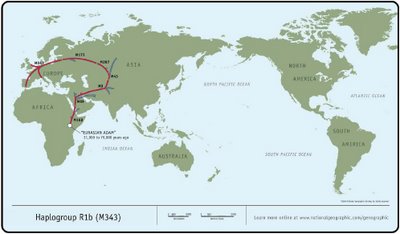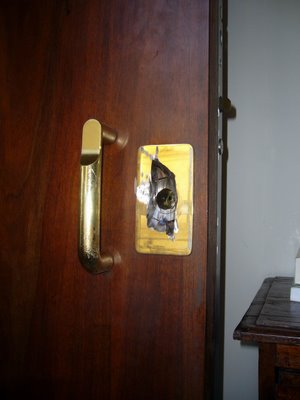Suite à un
précédent post, voici les résultats de mon analyse ADN réalisée par le Genographic Project. De nombreuses personnes en Europe appartiennent à ce haplogroupe.


HAPLOGROUP R1B (M343)
Your Y-chromosome results identify you as a member of haplogroup R1b.
The genetic markers that define your ancestral history reach back roughly 60,000 years to the first common marker of all non-African men, M168, and follow your lineage to present day, ending with M343, the defining marker of haplogroup R1b.
If you look at the map highlighting your ancestors' route, you will see that members of haplogroup R1b carry the following Y-chromosome markers:
M168 > M89 > M9 > M45 > M207 > M173 > M243
Today, roughly 70 percent of the men in southern England belong to haplogroup R1b. In parts of Spain and Ireland, that number exceeds 90 percent.
What's a haplogroup, and why do geneticists concentrate on the Y chromosome in their search for markers? For that matter, what's a marker?
Each of us carries DNA that is a combination of genes passed from both our mother and father, giving us traits that range from eye color and height to athleticism and disease susceptibility. One exception is the Y chromosome, which is passed directly from father to son, unchanged, from generation to generation.
Unchanged, that is unless a mutation a random, naturally occurring, usually harmless change occurs. The mutation, known as a marker, acts as a beacon: it can be mapped through generations because it will be passed down from the man in whom it occurred to his sons, their sons, and every male in his family for thousands of years.
In some instances there may be more than one mutational event that defines a particular branch on the tree. This means that any of these markers can be used to determine your particular haplogroup, since every individual who has one of these markers also has the others.
When geneticists identify such a marker, they try to figure out when it first occurred, and in which geographic region of the world. Each marker is essentially the beginning of a new lineage on the family tree of the human race. Tracking the lineages provides a picture of how small tribes of modern humans in Africa tens of thousands of years ago diversified and spread to populate the world.
A haplogroup is defined by a series of markers that are shared by other men who carry the same random mutations. The markers trace the path your ancestors took as they moved out of Africa. Ifs difficult to know how many men worldwide belong to any particular haplogroup, or even how many haplogroups there are, because scientists simply don't have enough data yet.
One of the goals of the five-year Genographic Project is to build a large enough database of anthropological genetic data to answer some of these questions. To achieve this, project team members are travelling to all corners of the world to collect more than 100,000 DNA samples from indigenous populations. In addition, we encourage you to contribute your anonymous results.
Your Ancestral Journey: What We Know Now
M168: Your Earliest Ancestor
Fast Facts
Time of Emergence: Roughly 50,000 years ago
Place of Origin: Africa
Climate: Temporary retreat of Ice Age; Africa moves from drought to warmer temperatures and moister conditions
Estimated Number of Homo sapiens: Approximately 10,000
Tools and Skills: Stone tools; earliest evidence of art and advanced conceptual skills
Skeletal and archaeological evidence suggest that anatomically modern humans evolved in Africa around 200,000 years ago, and began moving out of Africa to colonize the rest of the world around 60,000 years ago.
The man who gave rise to the first genetic marker in your lineage probably lived in northeast Africa in the region of the Rift Valley, perhaps in present-day Ethiopia, Kenya, or Tanzania, some 31,000 to 79,000 years ago. Scientists put the most likely date for when he lived at around 50,000 years ago. His descendants became the only lineage to survive outside of Africa, making him the common ancestor of every non-African man living today.
But why would man have first ventured out of the familiar African hunting grounds and into unexplored lands? It is likely that a fluctuation in climate may have provided the impetus for your ancestors' exodus out of Africa.
The African ice age was characterized by drought rather than by cold. It was around 50,000 years ago that the ice sheets of northern Europe began to melt, introducing a period of warmer temperatures and moister climate in Africa. Park of the inhospitable Sahara briefly became habitable. As the drought-ridden desert changed to a savannah, the animals hunted by your ancestors expanded their range and began moving through the newly emerging green corridor of grasslands. Your nomadic ancestors followed the good weather and the animals they hunted, although the exact route they followed remains to be determined.
In addition to a favorable change in climate, around this same time there was a great leap forward in modern humans' intellectual capacity. Many scientists believe that the emergence of language gave us a huge advantage over other early human species. Improved tools and weapons, the ability to plan ahead and cooperate with one another, and an increased capacity to exploit resources in ways we hadn't been able to earlier, all allowed modern humans to rapidly migrate to new territories, exploit new resources, and replace other hominids.
M89: Moving Through the Middle East
Fast Facts
Time of Emergence: 45,000 years ago
Place: Northern Africa or the Middle East
Climate: Middle East Semiarid grass plains
Estimated Number of Homo sapiens: Tens of thousands
Tools and Skills: Stone, ivory, wood tools
The next male ancestor in your ancestral lineage is the man who gave rise to M89, a marker found in 90 to 95 percent of all non-Africans. This man was born around 45,000 years ago in northern Africa or the Middle East.
The first people to Leave Africa likely followed a coastal route that eventually ended in Australia. Your ancestors followed the expanding grasslands and plentiful game to the Middle East and beyond, and were part of the second great wave of migration out of Africa.
Beginning about 40,000 years ago, the climate shifted once again and became colder and more arid. Drought hit Africa and the grasslands reverted to desert, and for the next 20,000 years, the Saharan Gateway was effectively closed. With the desert impassable, your ancestors had two options: remain in the Middle East, or move on. Retreat back to the home continent was not an option.
While many of the descendants of M89 remained in the Middle East, others continued to follow the great herds of buffalo, antelope, woolly mammoths, and other game through what is now modern-day Iran to the vast steppes of Central Asia.
These semiarid grass-covered plains formed an ancient "superhighway" stretching from eastern France to Korea. Your ancestors, having migrated north out of Africa into the Middle East, then traveled both east and west along this Central Asian superhighway. A smaller group continued moving north from the Middle East to Anatolia and the Balkans, trading familiar grasslands for forests and high country.
M9: The Eurasian Clan Spreads Wide and Far
Fast Facts
Time of Emergence: 40,000 years ago
Place: Iran or southern Central Asia
Estimated Number of Homo sapiens: Tens of thousands
Tools and Skills: Upper Paleolithic
Your next ancestor, a man born around 40,000 years ago in Iran or southern Central Asia, gave rise to a genetic marker known as M9, which marked a new Lineage diverging from the M89 Middle Eastern Clan. His descendants, of which you are one, spent the next 30,000 years populating much of the planet.
This large Lineage, known as the Eurasian Clan, dispersed gradually over thousands of years. Seasoned hunters followed the herds ever eastward, along the vast super highway of Eurasian steppe. Eventually their path was blocked by the massive mountain ranges of south Central Asia the Hindu Kush, the Tian Shan, and the Himalayas.
The three mountain ranges meet in a region known as the "Pamir Knot," located in present-day Tajikistan. Here the tribes of hunters split into two groups. Some moved north into Central Asia, others moved south into what is now Pakistan and the Indian subcontinent.
These different migration routes through the Pamir Knot region gave rise to separate lineages.
Most people native to the Northern Hemisphere trace their roots to the Eurasian Clan. Nearly all North Americans and East Asians are descended from the man described above, as are most Europeans and many Indians.
M45: The Journey Through Central Asia
Fast Facts
Time of Emergence: 35,000
Place of Origin: Central Asia
Climate: Glaciers expanding over much of Europe
Estimated Number of Homo sapiens: Approximately 100,000
Tools and Skills: Upper Paleolithic
The next marker of your genetic heritage, M45, arose around 35,000 years ago, in a man born in Central Asia. He was part of the M9 Eurasian Clan that had moved to the north of the mountainous Hindu Kush and onto the game-rich steppes of present day Kazakhstan, Uzbekistan, and southern Siberia.
Although big game was plentiful, the environment on the Eurasian steppes became increasing hostile as the glaciers of the Ice Age began to expand once again. The reduction in rainfall may have induced desertlike conditions on the southern steppes, forcing your ancestors to follow the herds of game north.
To exist in such harsh conditions, they learned to build portable animal-skin shelters and to create weaponry and hunting techniques that would prove successful against the much larger animals they encountered in the colder climates. They compensated for the lack of stone they traditionally used to make weapons by developing smaller points and blades microliths that could be mounted to bone or wood handles and used effectively. Their tool kit also included bone needles for sewing animal-skin clothing that would both keep them warm and allow them the range of movement needed to hunt the reindeer and mammoth that kept them fed.
Your ancestors' resourcefulness and ability to adapt was critical to survival during the last ice age in Siberia, a region where no other hominid species is known to have lived.
The M45 Central Asian Clan gave rise to many more; the man who was its source is the common ancestor of most Europeans and nearly all Native American men.
M207: Leaving Central Asia
Fast Facts
Time of Emergence: 30,000
Place of Origin: Central Asia
Climate: Glaciers expanding over much of Europe and western Eurasia
Estimated Number of Homo sapiens: Approximately 100,000
Tools and Skills: Upper Paleolithic
After spending considerable time in Central Asia, refining skills to survive in harsh new conditions and exploit new resources, a group from the Central Asian Clan began to head west towards the European subcontinent.
An individual in this clan carried the new M207 mutation on his Y chromosome. His descendants ultimately split into two distinct groups, with one continuing onto the European subcontinent, and the other group turning south and eventually making it as far as India.
Your lineage falls within the first haplogroup, R1, and gave rise to the first modern humans to move into Europe and eventually colonize the continent.
M173: Colonizing Europe The First Modem Europeans
Fast Facts
Time of Emergence: Around 30,000 years ago
Place: Central Asia
Climate: Ice Age
Estimated Number of Homo sapiens: Approximately 100,000
Tools and Skills: Upper Paleolithic
As your ancestors continued to move west, a man born around 30,000 years ago in Central Asia gave rise to a lineage defined by the genetic marker M173. His descendants were part of the first large wave of humans to reach Europe.
During this period, the Eurasian steppe lands extended from present-day Germany, and possibly France, to Korea and China.
The climate fostered a land rich in resources and opened a window into Europe.
Your ancestors' arrival in Europe heralded the end of the era of the Neandertals, a hominid species that inhabited Europe and parts of western Asia from about 29,000 to 230,000 years ago. Better communication skills, weapons, and resourcefulness probably enabled your ancestors to out compete Neandertals for scarce resources.
This wave of migration into Western Europe marked the appearance and spread of what archaeologists call the Aurignacian culture. The culture is distinguished by significant innovations in methods of manufacturing tools, more standardization of tools, and a broader set of tool types, such as end-scrapers for preparing animal skins and tools for woodworking.
In addition to stone, the first modern humans to reach Europe used bone, ivory, antler, and shells as part of their tool kit. Bracelets and pendants made of shells, teeth, ivory, and cawed bone appear at many sites. Jewelry, often an indication of status, suggests a more complex social organization was beginning to develop.
The large number of archaeological sites found in Europe from around 30,000 years ago indicates that there was an increase in population size.
Around 20,000 years ago, the climate window shut again, and expanding ice sheets forced your ancestors to move south to Spain, Italy, and the Balkans. As the ice retreated and temperatures became warmer, beginning about 12,000 years ago, many descendants of M173 moved north again to repopulate places that had become inhospitable during the Ice Age.
Not surprisingly, today the number of descendants of the man who gave rise to marker M173 remains very high in Western Europe. It is particularly concentrated in northern France and the British Isles where it was carried by ancestors who had weathered the Ice Age in Spain.
M343: Direct Descendants of Cro-Magnon
Fast Facts
Time of Emergence: Around 30,000 years ago
Place of Origin: Western Europe
Climate: Ice sheets continuing to creep down Northern Europe
Estimated Number of Homo sapiens:
Tools and Skills: Upper Paleolithic
Around 30,000 years ago, a descendant of the clan making its way into Europe gave rise to marker M343, the defining marker of your haplogroup. You are a direct descendent of the people who dominated the human expansion into Europe, the Cro-Magnon.
The Cro-Magnon are responsible for the famous cave paintings found in southern France. These spectacular paintings provide archaeological evidence that there was a sudden blossoming of artistic skills as your ancestors moved into Europe. Prior to this, artistic endeavors were mostly comprised of jewelry made of shell, bone, and ivory; primitive musical instruments; and stone carvings.
The cave paintings of the Cro-Magnon depict animals like bison, deer, rhinoceroses, and horses, and natural events important to Paleolithic life such as spring molting, hunting, and pregnancy. The paintings are far more intricate, detailed, and colorful than anything seen prior to this period.
Your ancestors knew how to make woven clothing using the natural fibers of plants, and had relatively advanced tools of stone, bone, and ivory. Their jewelry, carvings, and intricate, colorful cave paintings bear witness to the Cro-Magnons' advanced culture during the last glacial age.
This is where your genetic trail, as we know it today, ends. However, be sure to revisit these pages. As additional data are collected and analyzed, more will be Learned about your place in the histoly of the men and women who first populated the Earth. We will be updating these stories throughout the life of the project.






